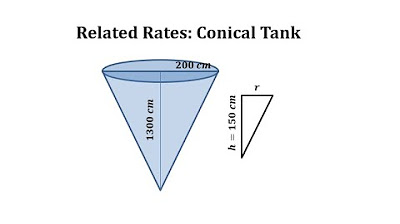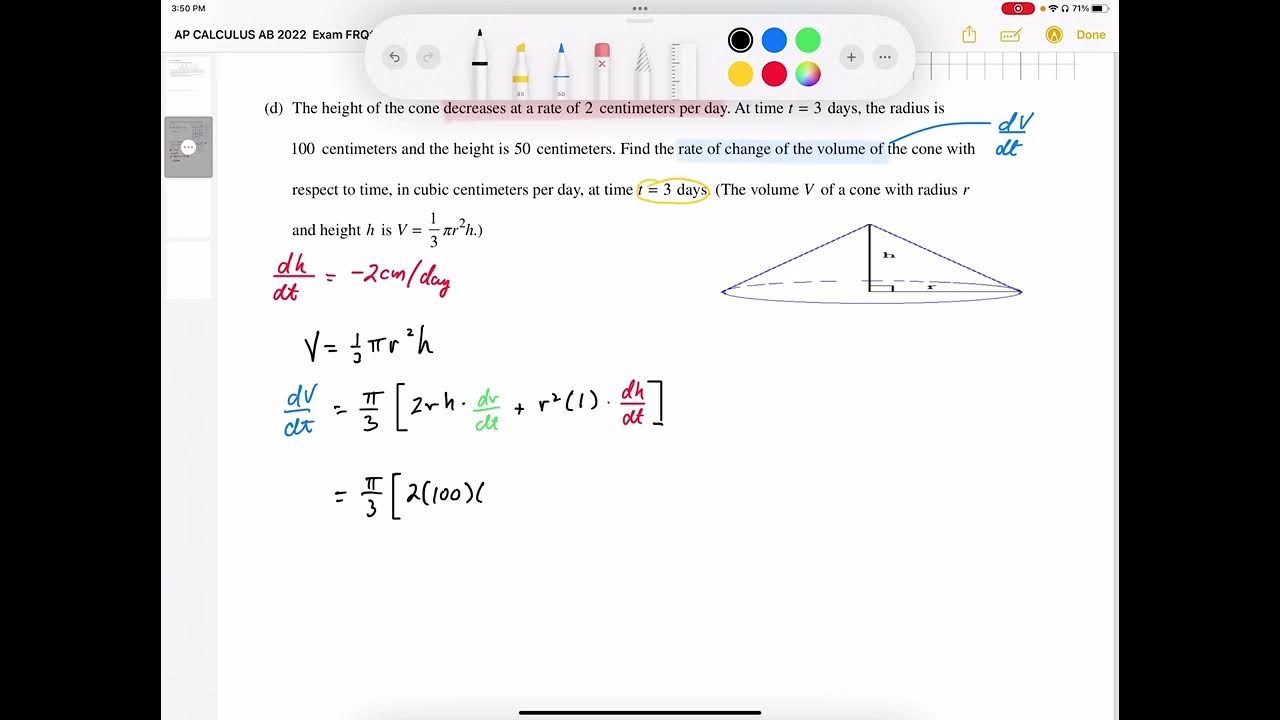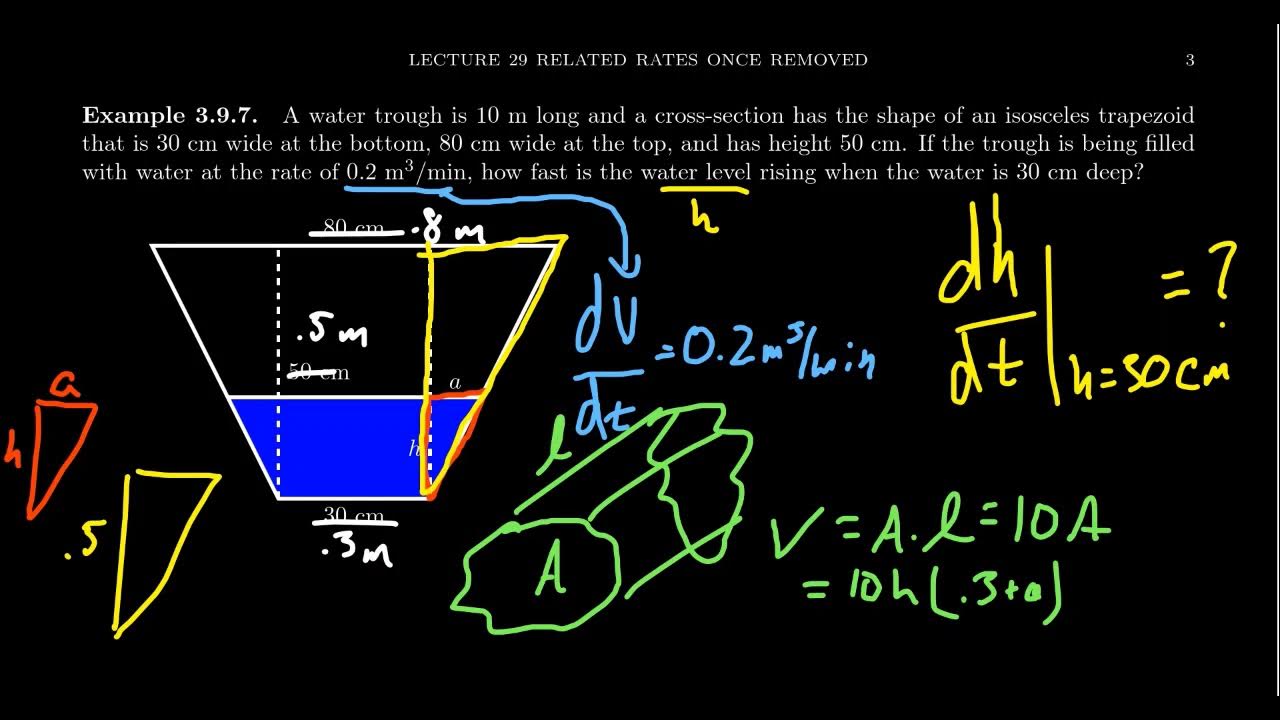Related Rates - Filling a Cone Problem
TLDRThe video script presents a related rates problem involving a water tank shaped like an inverted cone with a base radius of 3 meters and a height of 5 meters. The challenge is to find the rate at which the water level rises when the water is 3 meters deep, given that water is being pumped in at a rate of 3 cubic meters per minute. The solution involves understanding the geometry of cones, setting up ratios based on similar triangles, and applying calculus to find the rate of change of the water level (dh/dt). By using the volume formula for a cone and substituting the known ratio of radius to height, the problem is reduced to a function of height only. Taking the derivative with respect to time and substituting the given values, the video concludes with the rate of water level rise being 25/27π meters per minute, providing a clear and engaging explanation of the mathematical process.
Takeaways
- 📚 The problem involves a cone-shaped water tank being filled, which is a common type of related rates problem.
- 💧 The tank has a base radius of 3 meters and a height of 5 meters, and water is being pumped in at a rate of 3 cubic meters per minute.
- 📏 The rate at which the water level is rising needs to be found when the water is 3 meters deep.
- 🔍 Understanding the geometry of the cone and the rates involved is crucial for solving the problem.
- 📐 The cross-section of the inverted cone reveals a right triangle, which is key to solving the problem.
- 🌟 The volume of a cone is given by the formula (1/3)πr²h, where r is the radius and h is the height.
- 🔗 The triangles formed by the original cone and the filled portion are similar, leading to the ratio (R/H = 3/5).
- ➗ By substituting (R = 3/5H) into the volume formula, we get a volume function solely in terms of height.
- 🔄 Taking the derivative (dV/dt) with respect to time gives us an expression involving (dH/dt).
- ✅ Given (dV/dt = 3) cubic meters per minute and (H = 3) meters, we can solve for (dH/dt).
- 🏁 The final answer for the rate at which the water level is rising, when the water is 3 meters deep, is (25/27π) meters per minute.
Q & A
What is the shape of the water tank described in the video?
-The water tank has the shape of an inverted cone.
What are the dimensions of the base radius and height of the water tank?
-The base radius is 3 meters and the height is 5 meters.
At what rate is water being pumped into the tank?
-Water is being pumped into the tank at a rate of 3 cubic meters per minute.
What is the volume formula for a cone?
-The volume formula for a cone is 1/3 pi r^2 h, where r is the radius and h is the height.
How are the similar triangles in the cone related?
-The ratio of the radius to the height for both the larger and smaller cones is the same, which is 3/5.
What is the relationship between the radius and height of the smaller filled portion of the cone?
-The radius of the smaller portion is equal to 3/5 times the height of the smaller portion.
What rate are we trying to find in the problem?
-We are trying to find the rate at which the water level is rising, denoted as dh/dt.
At what depth are we looking to find the rate of water level rise?
-We are looking to find the rate when the water is 3 meters deep.
How is the derivative of the volume with respect to time represented?
-The derivative of the volume with respect to time is represented as dV/dt.
What is the final expression for the derivative of the volume of the water in the cone with respect to time?
-The final expression is 3pi/25H^2 dH/dt.
What is the final calculated rate at which the water level is rising when the water is 3 meters deep?
-The final calculated rate is 25/27pi meters per minute.
What is the significance of understanding the geometry and rates in related rates problems?
-Understanding the geometry helps to visualize the problem and set up the correct equations. Knowing whether the rates are positive or negative is crucial for the correct interpretation of the problem. Taking a derivative is a key step in solving related rates problems.
Outlines
📚 Introduction to the Cone Volume Problem
The video begins by introducing a related rates problem involving a water tank in the shape of an inverted cone. The tank has a base radius of 3 meters and a height of 5 meters. The challenge is to find the rate at which the water level rises when the water is 3 meters deep, given that water is being pumped in at a rate of 3 cubic meters per minute. The presenter emphasizes the importance of understanding geometry, the direction of the rates (positive or negative), and the process of taking derivatives to solve the problem. A cross-section of the cone is used to establish a right triangle, which is key to solving the problem. The presenter also explains that as the tank fills, it forms a smaller cone within the larger one, and that the triangles formed are similar, allowing for the establishment of a ratio between the radii and heights of the two cones. The volume of a cone is given by the formula (1/3)πr²h, which is then manipulated to express volume as a function of height alone, using the established ratio.
🧮 Calculating the Rate of Water Level Rise
The presenter continues by differentiating the volume formula with respect to time to find dh/dt, the rate at which the water level is rising. By substituting the given values into the derived formula, the presenter calculates the rate at which the water level is rising when the water is 3 meters deep. The differentiation results in an equation involving a constant (3π/25), the height (H), and its square (H²). After substituting the known values (DV/DT = 3 cubic meters per minute and H = 3 meters), the presenter solves for dh/dt, which simplifies to 25/(27π) meters per minute. The presenter concludes by ensuring that the final answer includes the correct units, which in this case is meters per minute, providing a complete solution to the problem.
Mindmap
Keywords
💡Related rates
💡Inverted cone
💡Volume of a cone
💡Similar triangles
💡DV/DT
💡DH/DT
💡Chain rule
💡Substitution
💡Cubic meters per minute
💡Geometric understanding
Highlights
The video discusses a related rates problem involving a cone-shaped water tank.
The water tank has a base radius of 3 meters and a height of 5 meters.
Water is being pumped into the tank at a rate of 3 cubic meters per minute.
The goal is to find the rate at which the water level is rising when the water is 3 meters deep.
The cone's geometry is crucial for solving the problem, with similar triangles formed as the tank fills.
The ratio of the radius to the height of the smaller filled portion of the cone is equal to the ratio of the larger cone.
The volume of a cone is given by the formula 1/3 * π * R^2 * H.
The rate of change of volume with respect to time (dV/dt) is positive 3 cubic meters per minute.
The relationship R/H = 3/5 is used to express R in terms of H, simplifying the volume formula.
The volume formula is simplified to 3π/25 * H^3 to focus on the height function.
The derivative dV/dt is taken to find the rate of change of the water level (dh/dt).
The derivative of H cubed with respect to time is found using the chain rule, resulting in 3H^2 * (dh/dt).
By substituting the known values (dV/dt = 3 and H = 3), the rate of change of height (dh/dt) is solved.
The final solution for dh/dt is 25/27 * π, with units of meters per minute.
The problem-solving approach emphasizes understanding geometry, the rates' sign, and successfully taking derivatives.
The video provides a step-by-step guide to solving related rates problems involving cones.
The practical application is determining the rate at which the water level rises in a cone-shaped tank.
The video concludes with a reminder that understanding the problem and applying the correct mathematical concepts are key to the solution.
Transcripts
5.0 / 5 (0 votes)
Thanks for rating:





